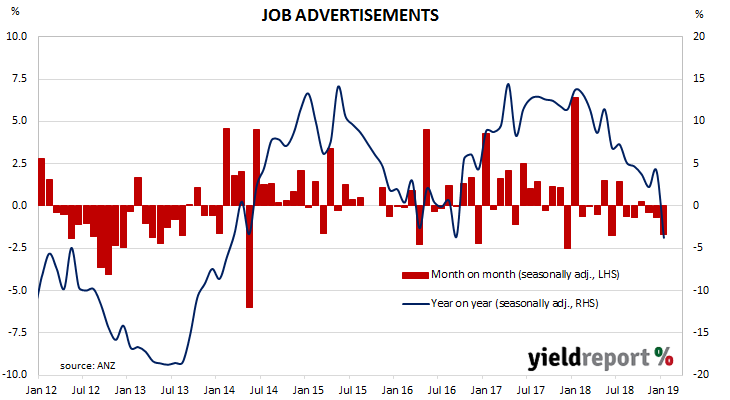ANZ’s job advertisement survey is well-known as a leading indicator of employment numbers in Australia. As such, it is inversely related to the unemployment rate. ANZ’s survey reflects changes in demand for labour and it provides another measure of activity in the economy. There is also a fairly good inverse relationship between changes in Australia’s unemployment rates and changes in the RBA cash rate. Understanding the path of Australia’s unemployment rate has historically provided a reliable indicator of RBA rate changes.
From mid-2017 onwards, year-on-year growth rates in the total number of advertisements consistently exceeded 10%. That was until mid-2018 when the annual growth rate fell back markedly and then tracked lower for the remainder of 2018.
January’s figures have now been released and, after revisions and seasonal adjustments, total advertisements fell by 1.7% to 171,392. On a 12-month basis, total job advertisements shrank by 3.7%, the first time the annual rate has gone into negative territory since September 2016.
 Local financial markets’ reactions were modest but there was also a December dwellings approval report and a Melbourne Institute Inflation Gauge report with which to contend. By the end of the Australian trading day, 3-year, 10-year and 20-year Treasury bond yields were all 2bps higher at 1.74%, 2.23% and 2.60% respectively. Cash futures prices were essentially unchanged; a bias towards a rate cut in late 2019 or early 2020 remained in place. The Aussie dollar finished the afternoon session about 0.2 US cents lower at 72.30 US cents.
Local financial markets’ reactions were modest but there was also a December dwellings approval report and a Melbourne Institute Inflation Gauge report with which to contend. By the end of the Australian trading day, 3-year, 10-year and 20-year Treasury bond yields were all 2bps higher at 1.74%, 2.23% and 2.60% respectively. Cash futures prices were essentially unchanged; a bias towards a rate cut in late 2019 or early 2020 remained in place. The Aussie dollar finished the afternoon session about 0.2 US cents lower at 72.30 US cents.

